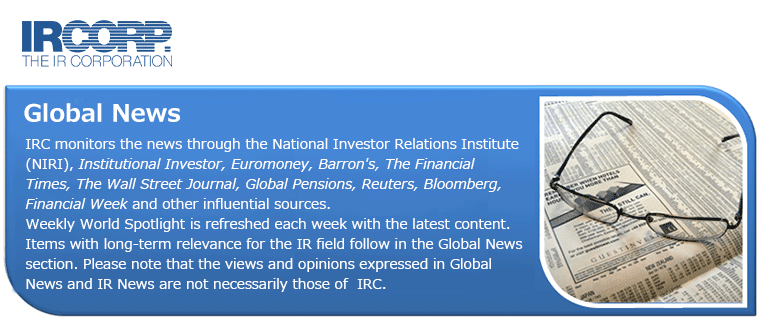Bloomberg (April 10)
“Global funds have turned optimistic on Japanese stocks over the past year, on expectation shareholder returns will improve.” Despite the booming Japan market, “Japanese startups have been turning to the US where institutional investors are more willing to bet on innovative technologies.” So it is no surprise that the NYSE “is actively engaged with a pipeline of Japanese companies, some of which may consider a US listing over the next 18 months.”
Tags: Booming, Expectation, Global funds, Innovative technologies, Institutional investors, Japan, NYSE, Optimistic, Shareholder returns, Startups, Stocks, U.S.
Reuters (May 26)
The NYSE “partially reopened its trading floor on Tuesday, having been closed since March 20. The question is why. It’s getting harder to argue the exchange, owned by Intercontinental Exchange, even needs such a thing. Trading didn’t suffer any noticeable glitches while it was closed.”
Tags: Closed, Glitches, Intercontinental Exchange, NYSE, Reopened, Trading floor
Wall Street Journal (July 8)
“The computer glitch that led to a halt in trading at the New York Stock Exchange on Wednesday shows that even after years of investments in resilient and redundant networks, problems with financial technology are remarkably persistent.” The four-hour shut down and other “recent problems highlight the challenges facing companies as they transition to a digital model. Many are trying to adopt new technologies while maintaining older systems.”
Tags: Computer, Digital model, Glitch, Investments, Networks, NYSE, Technology
Euromoney (October Issue)
Warning some stock exchanges could face downgrades, ratings agency S&P cautioned that they “have become more prone to operational risk.” Fragmentation is one key challenge. “There are now 16 SEC-registered securities exchanges in the US and more than 50 alternative trading systems, whereas before 2005 the equities market was dominated by NYSE and Nasdaq. It is this interconnectivity that is fueling operational risk. When Nasdaq halted trading in August, for example, other stock exchanges, including NYSE, Bats and Direct Edge, were also forced to stop trading in Nasdaq-listed securities.”
Tags: BATS, Challenge, Direct Edge, Downgrades, Fragmentation, Interconnectivity, Nasdaq, NYSE, Operational risk, S&P, SEC, Securities, Stock exchanges, Trading, U.S.
Institutional Investor (August Issue)
“Facing an image problem,” many Chinese companies are retreating from U.S. exchanges. “Frustrated by low valuations and investor skepticism, Chinese companies are increasingly considering delisting from U.S. stock exchanges.” Since 2009, 24 Chinese companies have delisted, often going private, from the NYSE and Nasdaq. Much investor skepticism is directed at companies that utilized reverse mergers to attain their listing, thereby avoiding the scrutiny that would accompany a normal IPO, but the skepticism has tainted even Chinese companies with solid financials.
Tags: China, Companies, Delisting, Image, Investors, IPO, Listing, Nasdaq, NYSE, Private, Reverse mergers, Scrutiny, Skepticism, Stock exchanges, U.S., Valuations
“New York Times (April 7, 2013)
U.S. regulators like FINRA need to confront today’s changing market where trading “has increasingly migrated away from public exchanges, like the New York Stock Exchange, to private trading venues, mostly operated by big banks.” With approximately 40% of trades being handled through dark pools and internalizers, markets are losing transparency and may become more susceptible to crashes and manipulation. Canadian and Australian regulators have already taken steps to protect their markets. U.S. regulators need to get with the program. “The market cannot be efficient if many orders never see the light of day. An inefficient market is neither fair nor stable, which makes a strong regulatory response to protect investors imperative.”
Tags: Australia, Canada, Dark pools, Efficient markets, FINRA, Investors, NYSE, U.S.
Wall Street Journal (December 22)
“How is it that a derivatives trading platform younger than Justin Bieber is about to acquire the New York Stock Exchange, which traces its Wall Street lineage to 1792? Thursday’s announcement that Intercontinental Exchange (ICE) will buy NYSE Euronext for about $8 billion is in part the story of a tech-savvy upstart that quickly grew to eclipse established giants.”
Tags: Acquisition, Derivatives, Ice, NYSE, Technology, Wall Street
New York Times (October 31)
“Still hobbled by power outages and waterlogged transit, the New York region struggled to return to the rhythms of daily life on Wednesday, while facing the reality of a prolonged and daunting period of recovery.” Both the NYSE and NASDAQ are scheduled to resume trading with Mayor Michael Bloomberg scheduled to “open the New York Stock Exchange on Wednesday morning after a two-day closure, the first for weather-related reasons since 1888.”
Securities Trader (August Issue)
We have moved “from the paper blizzard 50 years ago when average daily volume on the New York Stock Exchange was 14 million shares to today’s “slow” market, when 6 billion shares are traded each day, at a thousandth of a blink of an eye.” Today, “orders can get acknowledged in 310 millionths” of a second and some pre-trade risk controls take place in just two billionths of a second.
Tags: Acknowledgement, NYSE, Risk controls, Trading volume
Securities Technology Monitor (August 6)
High frequency trading “can wreak havoc in the global financial marketplace by amplifying moves on the up- and down-sides.” The “Knightmare on Wall Street” focused attention on this issue when a software glitch at Knight Capital caused almost 40 NYSE-listed stocks to move more than 10% in less than 60 minutes. “The problem with the rising popularity of High-Frequency Trading is that it may be distorting global financial markets significantly, increasingly destabilising those markets and causing the rise of systemic risk.”
High frequency trading “can wreak havoc in the global financial marketplace by amplifying moves on the up- and down-sides.” The “Knightmare on Wall Street” focused attention on this issue when a software glitch at Knight Capital caused almost 40 NYSE-listed stocks to move more than 10% in less than 60 minutes. “The problem with the rising popularity of High-Frequency Trading is that it may be distorting global financial markets significantly, increasingly destabilising those markets and causing the rise of systemic risk.”


